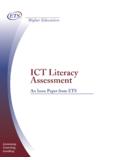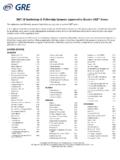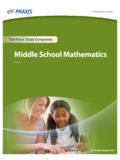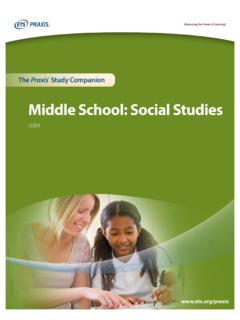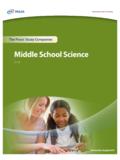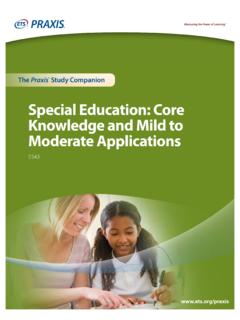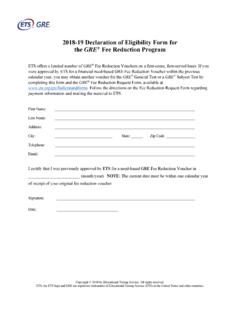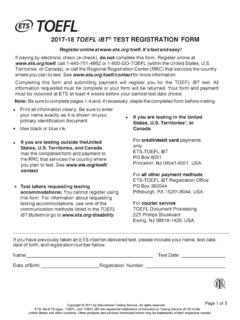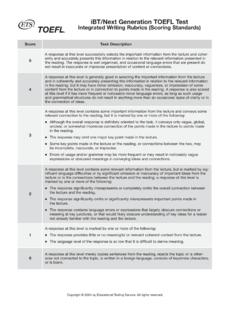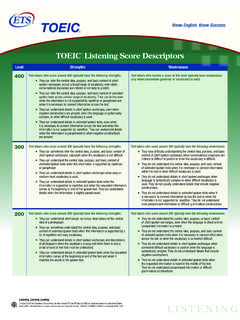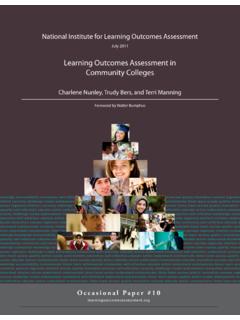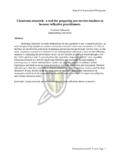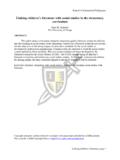Transcription of Linking Classroom Assessment - ETS Home
1 Linking Classroom AssessmentwithStudent Assessment is among an instructor s most essential educationaltools. When properly developed and interpreted, assessments can helpteachers better understand what their students are learning. By providing the means to gather evidence about what students know and cando, Classroom Assessment can help teachers Identify students strengths and weaknesses Monitor student learning and progress Plan and conduct instructionOngoing informal and formal Classroom Assessment Is the bond that holds teaching and learning together Allows educators to monitor teaching effectiveness and student learning Can motivate and shape learning and instruction Can help teachers gauge student mastery of required skills Can help teachers determine whether students are prepared for tests that are used for high-stakes decisions Can help students improve their own performancesClassroom assessments do more than just measure learning.
2 What we assess,how we assess, and how we communicate the results send a clear message to students about what is worth learning, how it should be learned, and how wellwe expect them to Assessment and instruction is critical to effective informative assessments requires strategic planning and a clear under-standing of one s Assessment goals. What needs to be assessed and why? Whenplanning instructional strategies, teachers need to Keep learning goals in mind Consider Assessment strategies Determine what would constitute evidence that students have reached the learning goalsAll of this needs to be considered within the context of instruction, rather than as an isolated step in the instruction cycle. To get the most out of assessments, youneed to know how to choose the right one for each situation, and how to make thattest as effective as possible.
3 A poorly chosen or poorly developed Assessment willfail to provide useful evidence about student learning. It could even provide mis-leading information. Only with good, properly chosen assessments will teachersgather evidence of what their students have can begin to create a process for developing and using Classroom assessmentsby asking the following basic but essential questions: What am I trying to find out about my students learning? What learning goals or outcomes do I want to measure? What kind of evidence do I need to show that my students have achieved the goals that I m trying to measure? What kind of Assessment will give me that evidence? Make it accurate and appropriate. Most importantly, an Assessment must provide the evidence it was meant to provide.
4 The Assessment must measure the knowledge, skills, and/or abilities the teacher believes are important. If the goal is to test for retention of facts, then a factual test ( , a multiple-choice or fill-in-the-blank Assessment ) may be the best choice. Measuring students conceptual understanding or ability to perform tasks usually requires more complex forms of Assessment , such as performance evidence this publication, Selected-responserefers to multiple-choice, matching, true-false, and similar questions in which a choice of answers is provided. Validityreflects the extent to which test scores actually measure what they were meant to measure. It is the single most important characteristic of good Assessment . Valid Assessment information can help teachers make good educational validity, an Assessment is useless.
5 Reliabiltyrefers to an Assessment s consistency. It is the extent to which a person repeating the Assessment or taking an alternate form of it would tend to get the same score, assuming that practice makes no it administering an Assessment to measure what students have learned in class,it is useful for instructors to ask themselves: Based on what I ve taught in class, canmy students be expected to answer this?For example, asking English language learners to carry on a discussion in Englishabout a class trip they took or a book that they all read would be very would not be appropriate or effective, however, to ask the same students to carryon a conversation in English about highway construction, if that topic has nothingto do with what they learned in Assessment should also reflect real-world ways that knowledge and understand-ing are used.
6 Assessments based on situations relevant to students own experiencescan motivate them to give their best performances. Use multiple sources of many sources of evidence helps teachers accurately interpret what each student really knows and can do. Informal, day-to-day measures of student progress include:- observation and questioning strategies- traditional paper-and-pencil tests ( , multiple-choice and short-answer) More elaborate forms of Assessment include:- essays - speeches - demonstrations- problem-solving activities The goal is to discover what students know and can do, not to create tricky single form of Assessment works well in all situations and for all assessments will fit certain Assessment goals and situations better than others.
7 Reasons for using a variety of assessments include the following: Each type of Assessment has its own strengths and weaknesses. Each form of Assessment provides a different type of evidence about what students know and can do. Taking advantage of more than one or two Assessment methods increases your ability to fully understand the range of student knowledge and skills. Some students will perform better on one type of Assessment than another. For example, some students will excel in a performance situation. Others are strongest when responding to multiple-choice questions. Similarly, what teachers can learn from an oral presentation about how students communi-cate may be very different from what they can find out when asking students to write an concept the need to use different sources of evidence is true of allassessment types.
8 Even multiple-choice assessments yield better information ifseveral different questions are used to assess each concept. The Assessment method a teacher chooses to use depends on the following: The nature of the information being taught The purpose of the instruction What the instructor wants to learn from the assessmentKnowing which Assessment to use can save valuable time. For example, performanceassessments, which ask students to perform a task rather than select an answerfrom a list, can be used to assess many different types of knowledge and skills atonce. They can also be easily incorporated into a curriculum without interruptingteaching and learning. In fact, they can be part of teaching and learning. Someexamples of performance assessments include having students give a speech; carryon a conversation about a specific topic; draft, review, and revise a poem; or conduct a survey and explain the results.
9 But, if you simply want to assess recognition, or if all you want to know iswhether students can identify a correct vocabulary usage, you probably don t wantto use a performance Assessment . It would be simpler, quicker, cheaper, and morerevealing to give students a series of sentences with blank spaces in which to insertvocabulary from a list of way to go? your professional judgment to weigh the benefits and drawbacks associated with eachassessment strategy before deciding which one to selected-response or fill-in-the-blank test Advantages They are easy to administer and score, and they can test a broad range of knowledge and skills quickly. Disadvantages Developing such tests to accurately measure more complex, higher-level thinking skills is difficult and time Assessment Advantages They evaluate student understanding, reasoning, and communication, and they can be used to determine how well students can apply their FORPLANNINGGOODASSESSMENTS1.
10 Have the purpose of the test clearly in Determine what type of Assessment would be most appropriate for the situation based on the nature of what you are teaching, the purpose of the instruction, and what you want to measure. (You can use the chart on pages 8-9 to help you with this step.)3. If the purpose of the Assessment is to determine how well students have mastered a particular unit of study, make sure the test parallels the work covered in If the Assessment is a selected-response or fill-in-the-blank test that will be used to diagnose basic skills, it should contain at least 10 questions preferably more for each skill area. The questions pertaining to each skill area should be considered a subtest, and those subtests should yield separate If the major purpose of the test is to rank a selected group of students in order of their achievement, the questions should cover critical points of learning.
